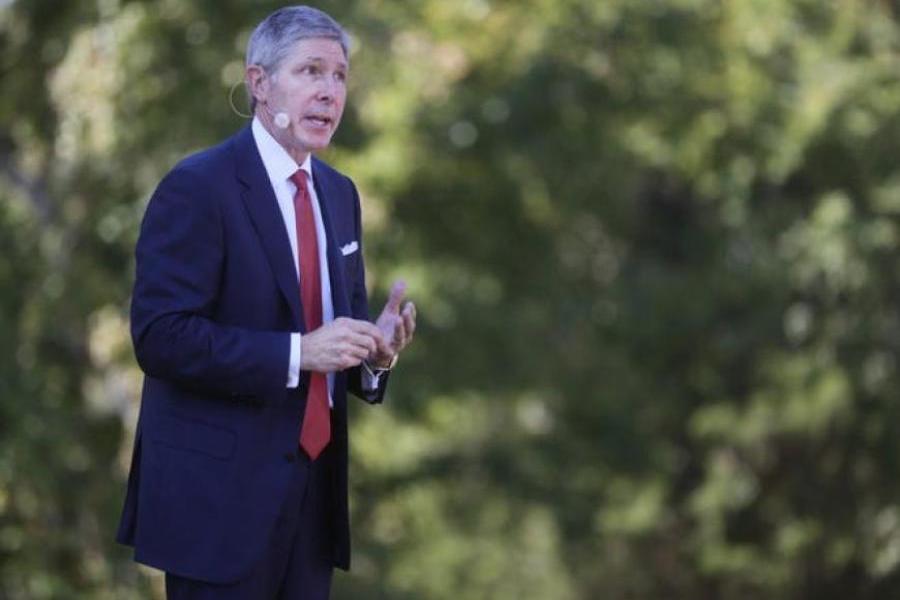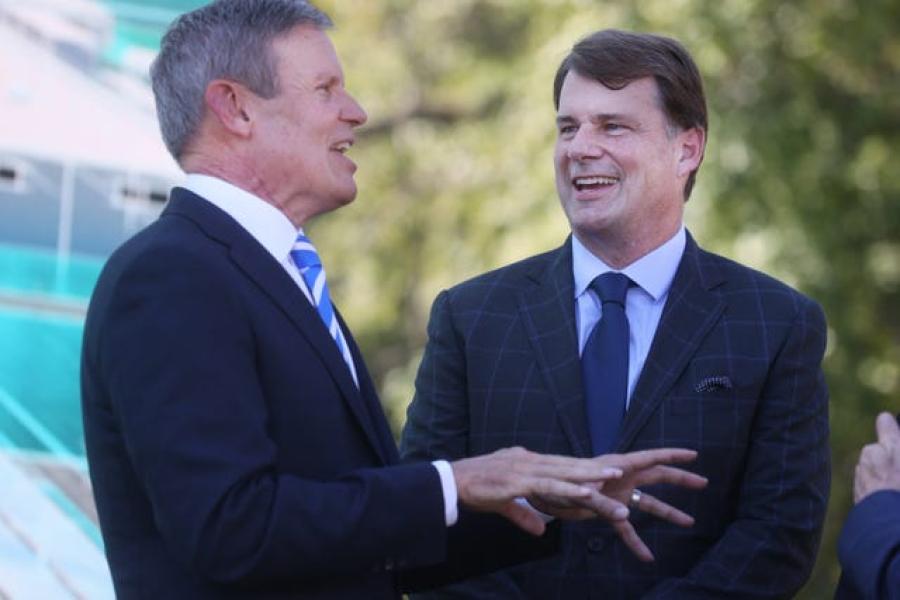Rolfe gives behind-the-scenes look at how Tennessee landed Blue Oval City

By KATE COIL
TML Communications Specialist
Well before officials with Ford, SK Innovation, and the state of Tennessee gathered in Stanton in September 2021 to make the monumental Blue Oval City announcement, work had been going on for months behind the scenes to secure what is the largest investment in state history and part of the largest manufacturing investment ever made by Ford.
Tennessee Department of Economic and Community Development (TNECD) Commissioner Bob Rolfe said the state had been marketing the Memphis Regional Megasite for a dozen years and had invested $226 million into the property when economic development officials received a fateful call in February of last year.
“We had been aggressively marketing the state’s industrial megasite going back over the last 12 years,” Rolfe said. “Unfortunately – or maybe fortunately – we had not been successful in this case, but being patient paid endorsement dividends. Ford Motor Company reached out to us in late February 2021, and like every project that is economic development-related, all major manufacturers are eager to get their product to market. A project like this could take a couple of years to evolve.”
Tennessee was one of 16 states that began competing to land the major new development.
“We were responsible for providing an enormous amount of data,” Rolfe said. “That included everything from workforce to the ability to deliver the amount of megawatts that Ford requires to water and wastewater. What made our challenge more interesting is that the megasite itself did not have any utilities, certainly not at the level and capacity requirements. The state had to provide water and wastewater for the site. We worked with TVA to make sure they could deliver the power. We worked with gas and fiber companies. We also had to convince Ford that we had a workforce that would be of size, of quality, and of skillset to meet that need of 5,800 full-time employees when the project opens.”
To meet these needs, ECD pulled in other state departments to work on the project.
“Our job at ECD is to recruit the companies, and to negotiate the transaction,” Rolfe said. “What was interesting about this project is it cuts across several departments in state government. TDOT is going to be responsible for building a lot of roads. General Services is going to be responsible for water and wastewater. The Tennessee Board of Regents is going to be responsible for building a TCAT on the Blue Oval campus. The Department of Labor and Workforce Development is responsible for helping prepare the workforce. You have all these departments working together. We at the state must deliver all of the promises we made to win this project.”
In addition to coordinating with other state departments and outside agencies, ECD officials also had to make sure every aspect of the massive project stayed under wraps.
“A lot of work went on behind-the-scenes, and what we were probably proudest of was not only the good work but the ability to keep this confidential,” Rolfe said. “We know from history and our business that if you leak you lose. That’s how they have leverage. Companies don’t want states or locals talking about a project until that company has made a very definitive decision. It’s not new to us to operate under maximum confidentiality.”
West Tennessee and the cities of Memphis and Jackson were also major selling points.
“The big winners will obviously be West Tennessee, Jackson, and Memphis,” Rolfe said. “Part of the conversations and part of the data points needed for this particular project were access to air service, great healthcare, entertainment, and education. The great news is when it comes to those great attributes Memphis and Jackson check all those boxes.”

Then in August, Rolfe and Gov. Bill Lee received a phone call from Bill Ford Jr., the executive chairman of the Ford Motor Company and great-grandson of company founder and auto industry pioneer Henry Ford.
“Seven months later, we were informed that the state of Tennessee had been identified as the winner of the Ford’s largest project ever. For the state of Tennessee – from a capital investment perspective – this was the largest investment at $5.6 billion. Bill Ford said that Tennessee was head and shoulders above the other states that competed for this project,” Rolfe said. “That is obviously a great attestation and affirmation that we delivered not only the answers they were looking for, but we also delivered the economic incentives to offset the cost. I’m not only talking about the incentives that were delivered to Ford Motor Company but the incentives that were delivered on infrastructure because this is a state-owned industrial park.”
A matter of weeks after the announcement, the Tennessee General Assembly came together to help put together the final piece of the Blue Oval puzzle: $844 million in incentives for the project.
“At the end of the day, it also takes a great General Assembly that is very supportive of these kind of capital investments,” Rolfe said. “This is an enormous commitment from our state’s perspective. The funding mechanism comes through the General Assembly, which we have a great working relationship with. The leadership of Gov. Bill Lee is very much a part of this success.”
One advantage Tennessee has as the Blue Oval City project develops is experience with original equipment manufacturers (OEMs) in the automotive industry.
“When you look at the automotive ecosystem across Tennessee, we have three OEMS: the Volkswagen plant, the GM/Saturn plant, and Nissan,” Rolfe said. “Now we are going to have a fourth plant that we are excited about. At the same time, that earlier automotive ecosystem has led to about 1,000 automotive companies to call Tennessee home. If you are one of the great Tier I, Tier II, or Tier III suppliers, you now have to be a part of this great shift from the internal combustion engine to the electric vehicle.”
Already, Rolfe said the state is gaining traction from other companies that work with Ford as suppliers.
“We are continuing to work hard to recruit these suppliers,” he said. “If you look at Volkswagen as a model, when they came to Tennessee they bought an enormous amount of real estate that wraps around the OEM. Volkswagen handpicked their Tier I suppliers to be with them on that campus. Ford has the same concept. Not only are the OEM and the battery going to be on this campus, but there should also be room for 10 to 12 Tier I suppliers that Ford and SK will handpick.”
Rolfe said West Tennessee will be reaping the rewards from what is a once-in-a-generation investment
“This is going to be a project that is transformational for decades,” Rolfe said. “You look at what happened to Spring Hill more than 30 years ago when GM/Saturn came in. They went from a population of 4,000 then to a population of 40,000 today. We hope that same kind of opportunity presents itself over in rural West Tennessee.”
The most important transformation coming out of Blue Oval City may not come from the vehicles rolling off the line but what the development will mean for Tennessee families.
“At the end of the day, this is going to be about great family wages,” Rolfe said. “These are the kinds of family wages that provide a higher quality of life. They give a family an income that may allow a larger home, an extra car in the garage, and an extra vacation. The quality of these jobs is something we are very excited about because that kind of prosperity in our rural areas of the state doesn’t show up and present itself every day.”

